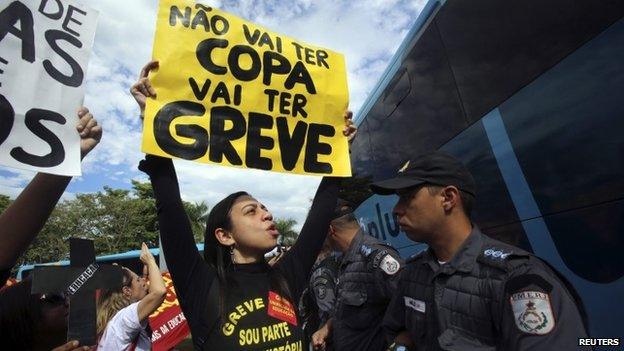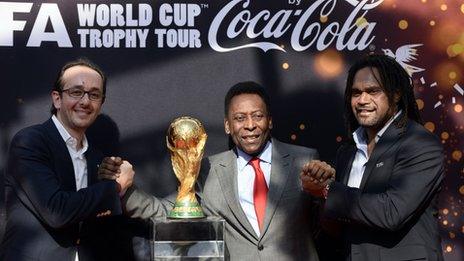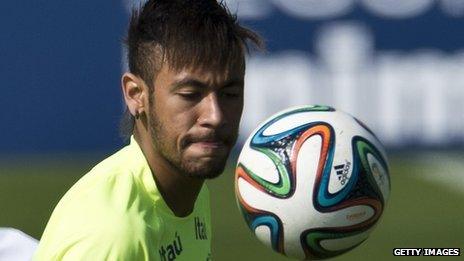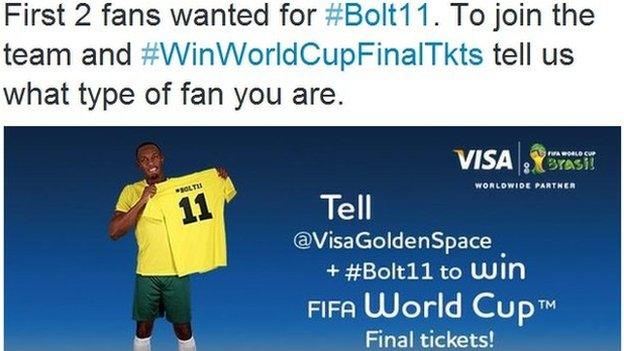World Cup 2014 sponsors face whole new ball game
- Published

A protester in Rio holds a sign saying: "There will be no World Cup, there will be strike"
Global football sponsorship is now much more than firms just handing over money to governing bodies such as Fifa for pitch-side promotion on billboards.
The relationship is now a much more textured one, with this year's World Cup sponsors aware of the growing non-commercial, and social and political, nuances around their role as financial backers of this huge sporting event.
This can be seen by the way Sony has involved itself in the furore around the awarding of the 2022 World Cup to Qatar.
Fellow sponsor Adidas says the ongoing issue is "neither good for football nor for Fifa and its partners".
And another massive backer, Coca-Cola, says it is prepared to tone down its branding message in the face of the re-emergence of social unrest in Brazil during the tournament.
'Realistic' approach
"Companies and brands are becoming increasingly aware, and have an added push and impetus towards showing ordinary people they are aware that there is a social aspect to being a sponsor," says Nigel Currie, from sports sponsorship agency Brand Rapport.
"When firms are involved in major sporting events like the World Cup there has to be an increased awareness of the outside world, and to take a more realistic approach to the world that people can respect."

Graffiti like this - depicting a hungry child offered a football to eat - expresses many Brazilians' discontent with the World Cup costs
He says that with such a high-profile tournament protest groups in Brazil were realising the potential of targeting not only the event itself but also sponsors. For instance, hacker group Anonymous has said it is preparing a cyber-attack on sponsor websites.
"The sponsors have to be ready for any potential banana skins that might come their way," he says.
So, with the 2014 tournament just days away, it means it is not just the 32 countries taking part that are fine-tuning their plans, but also the 22 corporate backers.
And according to one Brazilian expert, the big name sponsors are playing a more defensive game than usual.
"There is no disputing that the sponsors are a really important part of the World Cup," says Rio de Janeiro-based sports marketing consultant Amir Somoggi.
"However, some of the people and protesters on the streets are trying to put some of the guilt around the World Cup costs onto the sponsors.
"So sponsors are not launching their usual type of marketing strategies in case they are targeted by protesters. They are being slightly cautious, and for me, not being as major a part of the World Cup experience.
"But for me the blame for the increased costs should not be put on Fifa or the sponsors, but our politicians."
Three-tier structure
The sponsors have paid anything from an estimated £8m to £120m to have their names associated with what is one of the two biggest events in global sport.
And even if they are being more passive then usual, they will be getting their wares and services seen across most of the planet. During the last World Cup in South Africa there were reported to be more than 3.2 billion global TV viewers.

As well as being a World Cup sponsor, Coca-Cola has also backed the global trophy tour
Meanwhile, Fifa has also benefitted. By selling the rights for firms to be associated with the event, it is estimated to make some £850m over a four-year World Cup cycle, making up the majority of its non-TV revenues during such a period.
As was the case in South Africa, Fifa this year is operating three tiers of sponsorship, external:
a top tier of six premier commercial "global partners", who have a global marketing association with all Fifa events
a second tier of eight event "sponsors", who have a global association with just the World Cup and the Confederations Cup
a third tier of eight "local partners", or "national supporters", who have roots in the host country and are allowed to promote an association in the domestic market
Mr Currie says if the sponsor roster was a "merry-go-round or revolving door of changing names", firms might question the value of being involved. Rather there is a steady roster of big names staying on board for a number of tournaments.
"When you count the number of renewals you can see the value of the World Cup to big brands - Adidas has signed up for the next four World Cups until 2030, and Visa, Coca-Cola and Hyundai-Kia until 2022," says Mr Currie.

Sponsors Adidas have manufactured the Brazuca football for the 2014 event
Perfect storm?
Despite the lower-key approach, the main aim for sponsors will be to persuade football lovers to spend cash on their brands.
According to sports marketing research firm Repucom's World Football Report, which launches on 12 June, during the 2010 event about $4.12bn (£2.46bn) was generated globally for sponsors.
Some $907m of that amount was generated via the final alone.
This year is also expected to see a big increase in brand promotion via social media.
"Digital consumption... will be central to this World Cup. Brazil is also Facebook's second largest market and provides YouTube with its second most unique visitors," says Paul Smith, founder and chief executive of Repucom.
"Because of this, we could well see a perfect storm of fan engagement this tournament. Sponsors will of course be positioning themselves to take advantage of this."

Brands such as Visa will be using social media to activate their World Cup sponsorships
Integrated campaigns
Brands expert Anastasia Kourovskaia, of Millward Brown Optimor, agrees that social media "offers uniquely more intimate engagement", but in return "it requires a more well-designed and considered approach".
However, she says it is important that brands stop differentiating between online and offline media. "We live in an increasingly seamless world and successful social media campaigns are seamlessly integrated campaigns." she says.
She says a McDonald's food box campaign linked to the GOL! App is a good example of a successful integrated campaign.
But she adds that while campaigns have to be integrated, it is also important to understand how each platform works and tailor content to the specifics of each platform.
Looking to individual sponsors, she says Budweiser has plenty of initiatives around the tournament, including a "Rise as One" micro-site campaign, use of Twitter cards for voting for Man of the Match, as well as programmes for Instagram and Facebook.
Meanwhile, she also points to Adidas's initiative in providing a football match perspective from the point of view of @Brazuca, its official match ball.
"Cutting through the noise becomes ever more difficult, and if previously this could have been resolved by throwing more money in the pot, unfortunately it is no longer the case," says Ms Kourovskaia.
"Nowadays a bigger budget does not necessarily translate into higher reach and impact - creativity plays an enormous role."